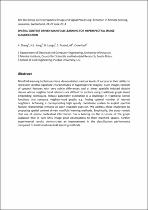JavaScript is disabled for your browser. Some features of this site may not work without it.
- ResearchSpace
- →
- Research Publications/Outputs
- →
- Conference Publications
- →
- View Item
| dc.contributor.author |
Zhang, Y

|
|
| dc.contributor.author |
Yangz, HL

|
|
| dc.contributor.author |
Lunga, D

|
|
| dc.contributor.author |
Prasad, S

|
|
| dc.contributor.author |
Crawford, M

|
|
| dc.date.accessioned | 2015-05-25T10:53:14Z | |
| dc.date.available | 2015-05-25T10:53:14Z | |
| dc.date.issued | 2014-06 | |
| dc.identifier.citation | Zhang, Y, Yangz, HL, Lunga, D, Prasad, S and Crawford, M. 2014. Spatial context driven manifold learning for hyperspectral image classification. 6th Workshop on Hyperspectral Image and Signal Processing: Evolution in Remote Sensing, Lausanne, Switzerland, 24-27 June 2014, pp 1-4 | en_US |
| dc.identifier.uri | http://hdl.handle.net/10204/7980 | |
| dc.description | 6th Workshop on Hyperspectral Image and Signal Processing: Evolution in Remote Sensing, Lausanne, Switzerland, 24-27 June 2014. Due to copyright restrictions, the attached PDF file only contains the abstract of the full text item. For access to the full text item, please consult the publisher's website. | en_US |
| dc.description.abstract | Manifold learning techniques have demonstrated various levels of success in their ability to represent spectral signature characteristics in hyperspectral imagery. Such images consists of spectral features with very subtle differences and at times spatially induced disjoint classes whose neighborhood relations are difficult to capture using traditional graph based embedding techniques. Robust parameter estimation is a challenge in traditional kernel functions that compute neighborhood graphs e.g. finding optimal number of nearest neighbors. Achieving a corresponding high quality coordinate system to exploit spectral feature relationships remains an open research question. We address these challenges by proposing spatial context driven manifold learning methods. Empirically, the study reveals that use of spatial contextual information has a bearing on the structure of the graph Laplacian that in turn links image pixel observations to their manifold spaces. Further experimental results demonstrate an improvement in the classification performance compared to traditional manifold learning methods. | en_US |
| dc.language.iso | en | en_US |
| dc.relation.ispartofseries | Workflow;13168 | |
| dc.subject | Manifold learning | en_US |
| dc.subject | Context dependency | en_US |
| dc.subject | Hyperspectral classification | en_US |
| dc.title | Spatial context driven manifold learning for hyperspectral image classification | en_US |
| dc.type | Conference Presentation | en_US |
| dc.identifier.apacitation | Zhang, Y., Yangz, H., Lunga, D., Prasad, S., & Crawford, M. (2014). Spatial context driven manifold learning for hyperspectral image classification. http://hdl.handle.net/10204/7980 | en_ZA |
| dc.identifier.chicagocitation | Zhang, Y, HL Yangz, D Lunga, S Prasad, and M Crawford. "Spatial context driven manifold learning for hyperspectral image classification." (2014): http://hdl.handle.net/10204/7980 | en_ZA |
| dc.identifier.vancouvercitation | Zhang Y, Yangz H, Lunga D, Prasad S, Crawford M, Spatial context driven manifold learning for hyperspectral image classification; 2014. http://hdl.handle.net/10204/7980 . | en_ZA |
| dc.identifier.ris | TY - Conference Presentation AU - Zhang, Y AU - Yangz, HL AU - Lunga, D AU - Prasad, S AU - Crawford, M AB - Manifold learning techniques have demonstrated various levels of success in their ability to represent spectral signature characteristics in hyperspectral imagery. Such images consists of spectral features with very subtle differences and at times spatially induced disjoint classes whose neighborhood relations are difficult to capture using traditional graph based embedding techniques. Robust parameter estimation is a challenge in traditional kernel functions that compute neighborhood graphs e.g. finding optimal number of nearest neighbors. Achieving a corresponding high quality coordinate system to exploit spectral feature relationships remains an open research question. We address these challenges by proposing spatial context driven manifold learning methods. Empirically, the study reveals that use of spatial contextual information has a bearing on the structure of the graph Laplacian that in turn links image pixel observations to their manifold spaces. Further experimental results demonstrate an improvement in the classification performance compared to traditional manifold learning methods. DA - 2014-06 DB - ResearchSpace DP - CSIR KW - Manifold learning KW - Context dependency KW - Hyperspectral classification LK - https://researchspace.csir.co.za PY - 2014 T1 - Spatial context driven manifold learning for hyperspectral image classification TI - Spatial context driven manifold learning for hyperspectral image classification UR - http://hdl.handle.net/10204/7980 ER - | en_ZA |






